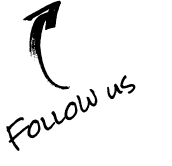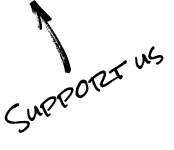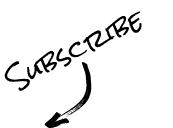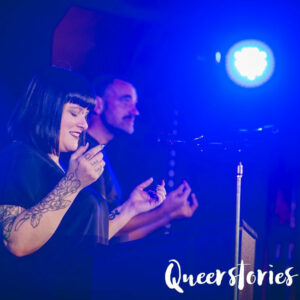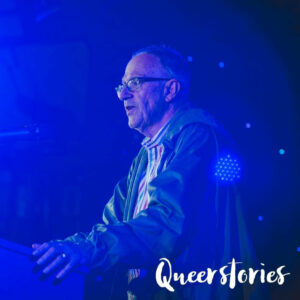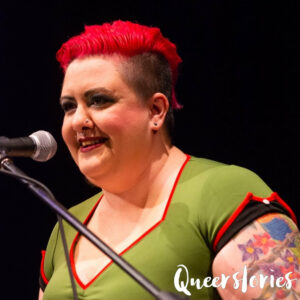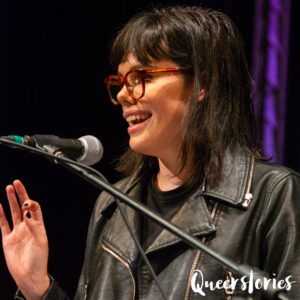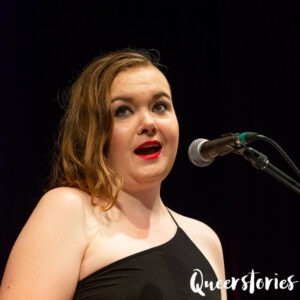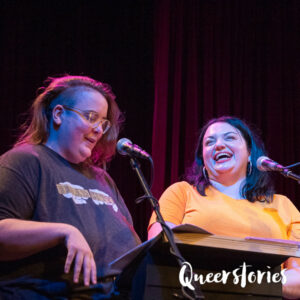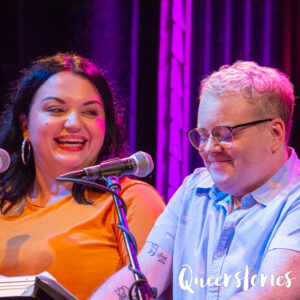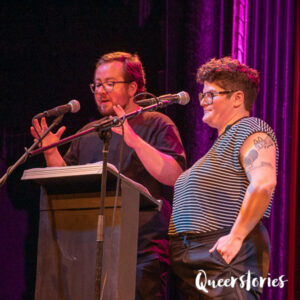Maeve: Hi, I’m Maeve Marsden, and you’re listening to Queerstories. This week, Fletcher Quilty was found face-down in a lovely bog when grunge was on the rise. He writes short-stories, poetry, and theatre. His words can be found in Jacaranda Journal, The Tundish Review, Sugarcane, PASTEL Magazine, and occasionally on a stage. By day (and also by night—it’s shift work) Fletcher is a radiographer with Queensland Health. He still smells of peat. Enjoy.
Fletcher:A patient arrives in the emergency imaging department. She’s smiling and bubbly, despite the sober hospital lighting. She’s queer-coding to the max. Pins, badges, undercut. A vision in black denim. On the right foot: eight-eye Doc Marten in rainbow glitter. On the left: a fashionable moonboot.
I lead her into the x-ray room and give her the regular spiel: “My name is Fletcher. I’ll be taking your x-rays today. Can you please confirm your full name and date of birth? We’re looking at your ankle? Great! Just because of your age and because we’re using radiation; is there any chance you could be pregnant?”
She gestures to herself vaguely and laughs, “I’m super gay.”
I make sure my Queensland Government WE SUPPORT ALL OUR EMPLOYEES rainbow pride lanyard is visible [laughter] and I gesture towards my vaguely androgynous self, also in Docs, and reply “Oh same! Big mood.” I’m a professional. But I have to ask, and gays can still get pregnant.
She confirms she isn’t, and then we get some beautiful ankle pictures. Not even my queer arch-colleague Kara could have faulted them. No seriously, once when I found Kara had done something wrong with an x-ray it was like the greatest day of my life. That’s queer solidarity. There is no greater shortcut to build radiographer-patient rapport like you both being absolutely, in her words, super gay.
Now a few years ago, I was working at a private clinic, and I had this nurse friend Jack. Jack had this rainbow pride lanyard. The story goes that Grace Grace— you know, Queensland Laor MP for McConnel— she gave Jack her lanyard at the Brisbane Pride March a few years back. Apparently, Grace Grace is out there like Princess Leia at the end of A New Hope just kind of bestowing queer visibility on people.
Now I try not to be a covetous person. But boy did I covet that lanyard. I see a thing with a rainbow on and I’m like take my pink dollars. And it’d look lovely against my black radiographer scrubs. Consumerism really knows how to get one up on me there.
Now a couple of years run by, and the falls out of my mind. I apply for a radiographer job at the hospital Jack works at. I’m craving some professional growth, looking to expand my skill set and so forth. Heck, I might want to go overseas in the next couple of years, and working in a hospital is a good stepping stone towards that. Now eventually, I’m offered the job. And like a lil rainbow souffle rising in the oven, the lanyard’s existence springs back into my mind.
Now did I accept my current job because of the slim possibility of acquiring a Queensland Government rainbow lanyard? Well, no. Maybe a little bit.
Now as I settle into my new job, I realise I’ve made a fatal error. These lanyards are thin on the ground. In a hospital staffed by about 3200 people, I see maybe five staff wearing them, including Jack. There’s an anaesthetist in theatre. A ward doctor I sometimes see in the cafe. A couple of nurses I’ve never met. Maybe some admin staff.
Now eventually I’m trapped in a lift with a lanyard wearer (or to put it more accurately they’re trapped with me), and I make a point to comment on how much I love it, and I ask where they got it. And they say “Oh they handed them out a few years ago, when the marriage equality plebiscite was happening.”
That’s not a helpful answer for me. That’s not the answer I’m looking for.
I joined Queensland Health Rainbow Network, and they ask for my address to send a welcome pack—perhaps with a lanyard—but it never comes. I look at some other rainbow lanyards online. But they aren’t the official Queensland Government one.
So I’m in my job for about six months, and February 2020 kind of rolls around. You know, it feels like about ten years ago? And I open my work email to an unread message.
“Hi everyone! ED nurse Liz is selling these lanyards for $5. If you would like one just find her in ED or email her.”
A picture is attached, and it’s the lanyard. The email is a couple of days old, and I go into full panic mode. So I frantically email Liz asking if she has any left. And she does! And she puts one aside for me. I run down to emergency to find her, and I give her a $5 note (literally pink dollars), and I have in my possession, finally, the lanyard. And Liz says, “oh, I’ve got 250 to sell if you know anyone else who wants one.”
Now I’ve had some lovely interactions with queer patients. But soon after I get my lanyard, a patient’s lying on the CT scanner and I get the sense my lanyard not going to mean much to her, or that it might even provoke her to kind of express an opinion.
Now I try to approach all patients from a compassionate viewpoint, people have different backgrounds and in hospital they’re at their most vulnerable. I often see patients on the worst day of their life. The worst day of their life so far. But, you know how in Australia we have this kind of reverse-formality culture? When you call someone by their first name it’s kind of a sign of equality and respect. Sir or ma’am? It’s kind of almost condescending in Australian vernacular.
This patient is getting the full ma’am. We can call her Karen if we like. She turns to me as I’m explaining the scan, and I can tell that she’s not really listening to me and she interrupts with “are you a man or a woman?”
Now one of the boons of queerness is that we’re forced to interrogate who we are and how we relate to the world around us. Hierarchies, systems of oppression, gender, sexuality, identity is complicated. But the little rusty cogs in my brain grind to a halt and I blurt out “man.”
Now my colleague at the time, a young straightman, he’s at the CT console behind the lead glass, and he hears this interaction. Bless his heart, he’s so concerned. Now once we’re out of patient earshot, he asks if I’m okay and makes a bit of a fuss, but ultimately you can’t tear the smile off my face. I’m androgynous. I’m unknowable. I’m enigmatic. These are all the words I’ve always wanted to be. I’ve never been better.
The weeks roll on, and COVID hits. We clear a ward for COVID patients, and expand our ICU capacity. We do hundreds of mobile chest x-rays while wearing full PPE, often for the whole shift. Gowns, gloves, masks, face-shields. It’s heavy. It’s hot. It’s sweaty. We start to envy those who can work from home. And even those that are unemployed.
But I see rainbows peeking out from behind semi-translucent gowns, and around necklines. More and more colleagues, queer and allies alike, are wearing them. And it gives me something to keep coming back for. In a time where we’re trapped in our homes and removed from community, it gives me a sense of belonging.
But now that so many allies are wearing them, how will I find a husband? That’s a joke. I’ve literally never seen a straight man wearing one. Wonder what that’s about! I don’t know.
The protocols around COVID change daily, then weekly, then eventually we assess on a patient-by-patient basis. We stop wearing full PPE for our shifts and ED is replete with rainbow lanyards. I now have several. Sometimes I buy more and then I give them to people. Who’s Princess Leia now, Grace Grace?
I never ask Liz how she got the lanyards. I’m afraid it’s an easy answer and I was just being a dumbass. I will ask one day, when my curiosity gets the better of me. But just for the moment, I’m happy to live in ignorance. I’m hoping it’s just a case of the age-old queer adage: lesbians get shit done.
A patient arrives for a CT scan. They’re in their fifties. I glance through their medical history, and see they’re trans. I make sure my lanyard’s on display. I ask for their full name and date of birth, and I confirm that it’s the name they’d prefer me to call them. They’re reading a sci-fi novel, and as a bit of a Star Trek boy I ask if they can suggest anything by the same author, Peter F Hamilton. They recommend I read Pandora’s Star. I still haven’t, but I’m a little bit of a literary boy, and I’ve got a big stack of books to get through. I’ll get there.
I never find out what happens to them. Or any of the other patients. That’s the funny thing about radiography. Through imaging, you get a glimpse or a snapshot of their story. You get to read a page, a paragraph, even a sentence. And you rarely ever see them again. But even if it’s just for a moment, I’m grateful see, and to be seen in return.
[Applause]
Maeve: Thanks for listening. Please rate, review, and subscribe to the podcast, and if you enjoy Queerstories, please consider supporting the project for as little as $1 per month on Patreon. The link is in the episode description.
Follow Queerstories on Facebook for updates, and for insomnia rants and photos of my glorious dog, follow me Maeve Marsden on Twitter and Instagram.


